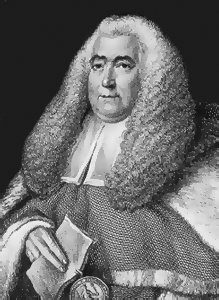
Sir William Blackstone
1. “[The Sanhedrin] called [Peter and John] and commanded them not to speak or teach at all in the name of Jesus. But [they] replied, ‘Judge for yourselves whether it is right in God’s sight to obey you rather than God'” (Acts 4:18-19).
2. Sir William Blackstone, the father of English law, defined liberty of expression as freedom from previous restraint by the government or its officers (late 1700s).
3. Three types of prior restraints were practiced by the English crown: seditious libel, licensing and taxation. All were motivations for writing of the First Amendment.
4. Near v. Minnesota (1931) adopted the no prior restraint doctrine with four exceptions: (a) national defense, (b) obscenity, (c) speech with all the effect of force or fighting words, and (d) speech that disrupts peace and quiet.
5. Post-publication punishments were left in place by Near, e.g., libel and invasion of privacy damages.
6. Grosjean v. American Press Co. (1936) opposed discriminatory taxation of papers, one of the historic prior restraints.
7. Martin v. Struthers (1943) approved time-place-and-manner restraints if rights are preserved for willing recipients, unwilling recipients and communicators.
8. Bantam Books v. Sullivan (1963) produced this language: “Any system of prior restraint comes to this court bearing a heavy burden of presumption against its constitutionality.”
9. New York Times v. U.S. (1971), the Pentagon Papers case, produced a two-edged sword: an eight-day prior restraint precedent but an eventual media victory.
10. Nebraska Press Association v. Stuart (1976) applied the Bantam Book formula in criminal proceedings.
11. Texas v. Johnson (1989) reversed a flag burning conviction. The conviction was akin to seditious libel, one of the historic prior restraints. A proposed constitutional amendment: “The Congress shall have the power to prevent the physical desecration of the flag of the United States.”
12. Simon & Schuster v. New York Crime Victims Board (1991) ruled states can’t show compelling interest to justify seizure of criminals royalties for their crime stories.
13. R.A.V. v. St. Paul (1992) ruled hate speech cannot be banned based on its content. Communicators of “messages of racial, gender or religious intolerance” may not be punished merely because of offensiveness and painfulness.
14. Wisconsin v. Mitchell (1993): “A physical assault is not by any stretch of the imagination expressive conduct protected by the First Amendment,” wrote Rehnquist.
